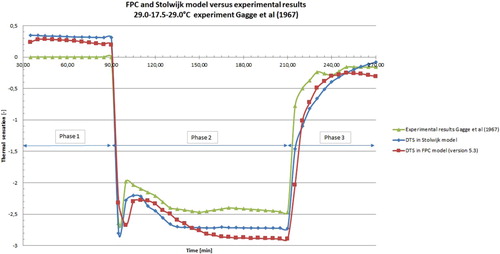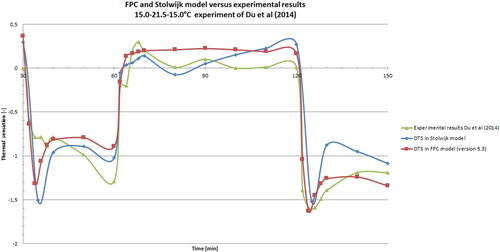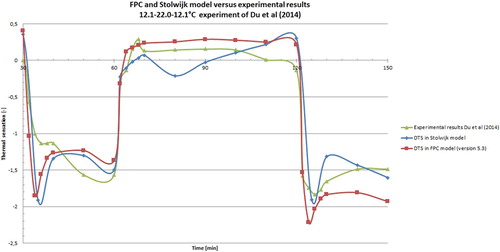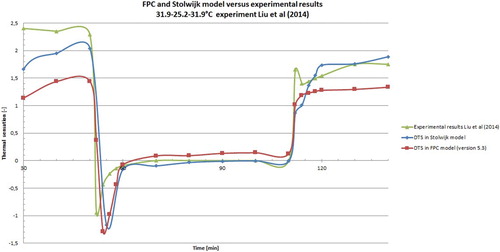ABSTRACT
Stolwijk developed a thermophysiological human model which, to day, is still the basis and inspiration for many other thermophysiological human models. The Stolwijk model used in this study is improved with regard of the calculation of the skin temperature and equipped with clothing as well as thermal sensation. Fiala also developed a thermophysiological model, based on the Stolwijk model, and is currently considered to be the latest development in thermophysiological human models. The current version of the Fiala model is known in practice as the Fiala thermal Physiology and Comfort (FPC) model. In the FPC model an equation is included to predict the thermal sensation under dynamic conditions, the so called Dynamic Thermal Sensation (DTS), based on the simulated core temperature and the mean skin temperature. This DTS-model was developed based on the subjects’ votes in early studies, which did not involve physiological measurements; instead, Fiala used his physiology model to predict the skin and the core temperatures from environmental variables measured in the tests. The correlations are therefore specific to the Fiala physiology model. In order to find out to what extent the DTS calculation results of the modified Stolwijk model deviate from the FPC model (version 5.3), in this study a number of variant calculations were carried out. Three well described and known scientific experiments from the professional literature are used for this, for a homogenous step-change transient thermal environment and for sedentary activity.
Introduction
There has been a growing demand from research and the industry for detailed models predicting human thermophysiological responses. Thermophysiological models are necessary for the design of the indoor thermal climate. Stolwijk and Hardy (Citation1966) developed a thermophysiological human model which, to day, is still the basis and inspiration for many other thermophysiological human models (Katic, Zeiler, and Boxem Citation2014). The multizonal Stolwijk model as compared to the better known two-node Gagge model (Gagge, Fobelets, and Berglund Citation1986) was more extensive in scope, e.g. because the heat balance of the body is divided into the head, the trunk, arms, hands, legs and feet. Some later on developed thermophysiological models are usually tailored to specific applications, for instance the cold side of the comfort zone (Gordon Citation1974) or Chinese people (Zhou et al. Citation2014). Often the source code of the computer programs of these models are not released and the computer programs are not made available for the professional practice. The Stolwijk model is made available by NASA and, precisely because of the availability of the source code, still used for research in the industry and research community by among others NASA (Miskovish, Byerly, and Miller Citation2014), the Biophysics and Biomedical Modeling Division US Army Research Institute of Environmental Medicine (Berglund, Yokota, and Potter Citation2013) and universities (Munir, Takada, and Matsushita Citation2009; Munir et al. Citation2010; Ingegneria medica Universita’ di Tor Vergata Roma Citation2016). The Stolwijk model used in this study is improved with regard of the calculation of the skin temperature and equipped with clothing as well as thermal sensation, as described in (Roelofsen and Vink Citation2016; Roelofsen Citation2016).
In 1998 Fiala also developed a thermophysiological model (Fiala Citation1998), based on the Stolwijk model and is currently considered to be the latest development in thermophysiological human models. The current version of the Fiala model is managed and operated by the company Ergonsim and is known in practice as the Fiala thermal Physiology and Comfort (FPC) model. In the FPC model an equation is included to predict the thermal sensation under dynamic conditions, the so called Dynamic Thermal Sensation (DTS), based on the simulated core temperature and the mean skin temperature. Fiala’s DTS-model was developed based on the subjects’ votes in early studies carried out at the Kansas State University, which did not involve physiological measurements; instead, he used his physiology model to predict the skin and the core temperatures from environmental variables measured in the tests. Fiala’s regression analysis is therefore based on the votes of human subjects and simulated skin and core temperatures. The correlations are therefore specific to Fiala’s physiology model (Zhang Citation2003).
In order to find out to what extent the DTS calculation results of the modified Stolwijk model deviate from the FPC model (version 5.3), in this study a number of variant calculations were carried out. Three well described and known scientific experiments from the professional literature are used for this, for a homogenous step-change transient thermal environment and for sedentary activity.
Stolwijk model
Passive part
The passive part of the model consists of five cylinders and a sphere with adjusted dimensions (the dimensions are determined by measurements on subjects) (). The cylinders represent the trunk, arms, hands, legs and feet, the sphere represents the head. Each element consists four concentric layers or compartments that comprise the core, the muscle tissue, the fat and the skin layers. The model also contains a central blood compartment, which represents the large arteries and veins. In this compartment heat is exchanged with the other compartments by convective heat distribution (this occurs when blood flows to the other compartments). The model assumes that the body is symmetrically built up; the legs are represented by one cylinder. The total passive system consists of 25 nodes: five cylinders and a sphere, each consisting four layers, and one central blood compartment.
Figure 1. Schematic representation of the passive part of the Stolwijk model (Stolwijk and Hardy Citation1977).
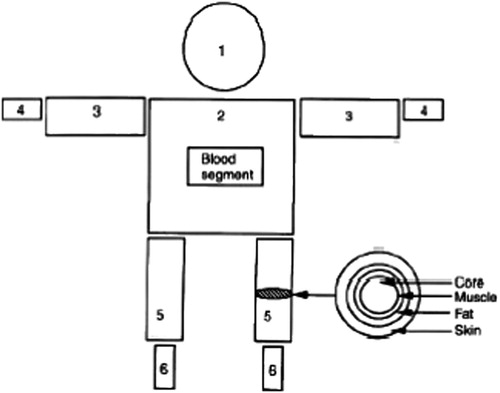
Active part
The active part of the model is the thermoregulation system () which perceives the ambient temperature and consists of an integrated and regulatory system. It is a simplified representation of the actual human thermoregulation system and is based on set point values. The set point value is basically the temperature for each node that a node would have in a neutral condition. If the value in a node is different from this set point value then the regulatory mechanisms are used.
Figure 2. Schematic representation of the active part of the Stolwijk model (Stolwijk and Hardy Citation1977).
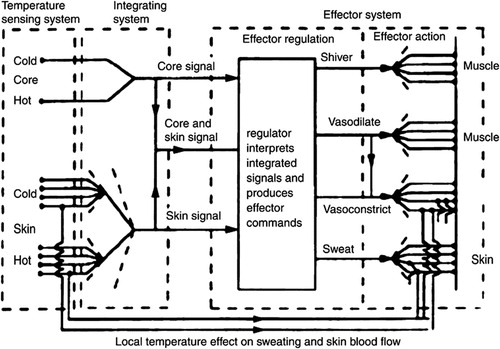
Modifications Stolwijk model
Skin temperature
The characteristics of the multi-segmented human thermal model of Stolwijk were evaluated by Munir, Takada, and Matsushita (Citation2009) using skin temperature measurements at low activity in transient environments by comparing the results of two series of experiments, involving ten and seven subjects. The subjects were exposed to stepwise changes in environmental conditions, including neutral, low, and high ambient temperatures. It was concluded that the original Stolwijk model accurately predicted the absolute value of and the tendency of the transient mean skin temperature. This suggests that the original Stolwijk model was valid for the prediction of the transient mean skin temperature of an ‘average’ person in low-activity conditions. Some of the body segments showed deviations of local skin temperature. Modification of the distribution of the basal skin blood flow and the distributions of vasoconstriction and workload significantly improved the predicted results of both thermally neutral condition and thermal-transient conditions (Munir, Takada, and Matsushita Citation2009).
The above mentioned modifications are displayed in (Munir, Takada, and Matsushita Citation2009) and included in the modified Stolwijk model (Roelofsen and Vink Citation2016).
Clothing
The original Stolwijk model was not equipped with clothing. In order for the model to be useful in the evaluation of the thermal comfort within the built environment it is necessary that clothing can be included in the assessment. For that reason, the Stolwijk model, for all body segments, is modified, as described in (Roelofsen and Vink Citation2016).
In this study the calculation of the clo value is executed with a computer program, based on a model of J. Lotens (Woerlee Citation1982). It calculates the clothing insulation values for a four cylindrical model of the human body. The model is covered with a clothing layer except for head and hands.
Dynamic thermal sensation (DTS)
In the FPC model an equation is included to predict the thermal sensation under dynamic conditions, the so called Dynamic Thermal Sensation (DTS), based on the simulated core temperature and the mean skin temperature. The equation for predicting the thermal sensation is based on a large number of independent experiments. Using a multivariate analysis it was found that the mean skin temperature, the core temperature and the rate at which the mean skin temperature changes are the parameters affecting the thermal sensation under dynamic conditions. The thermal sensation was assessed on the basis of the ASHRAE seven-point scale. Experiments showed that the predicted DTS and the Predicted Mean Vote (PMV) (NEN-EN-ISO-Citation7730 Citation2005) were in agreement (Fiala Citation1998). In the studies of Fiala two versions of the Dynamic Thermal Sensation (DTS) were published. Both versions are included in the modified Stolwijk computer model, but the one used for this study is published in (Fiala, Lomas, and Stohrer Citation2003) and is calculated as follows:
DTS (Fiala, Lomas, and Stohrer Citation2003)
Where:
Fiala model
In 1998 Fiala developed a thermophysiological model (Fiala Citation1998), based on the Stolwijk model. As with the Stolwijk model, the model of Fiala is split into passive and active parts. The original model of Fiala also assumes a standard male person weighing 73.5 kg, a body fat percentage of 14%, a Dubois area of 1.9 m² and a basal metabolic rate of 87.1 Watt.
The current FPC model (version 5.3) however has undergone significant changes, modifications and extensions. In the FPC model the human body is modelled as 20 compartments consisting of 366 tissue nodes; the active system has been further developed and optimized. The passive system incorporates a reference humanoid model, which reproduces an average person obtained from anthropometric field studies. The new reference model represents a 35 years old, unisex person weighting 71.4 kg, 169.7 cm tall, with a skin surface of 1.83 m2, and body fat content of 22.6% (Ergonsim Citation2016).
Variant calculations
In order to find out to what extent the DTS calculation results of the modified Stolwijk model deviate from the current FPC model, a number of variant calculations were carried out. Three well described and known scientific experiments from the professional literature are used for this, for a homogenous step-change transient thermal environment and for sedentary activity. In all graphs below, three phases can be identified with an environmental condition that deviates from the environmental condition in the subsequent phase, as once explicitly shown in .
Experiments of Gagge, Stolwijk, and Hardy (Citation1967)
In the experiments of Gagge, Stolwijk, and Hardy (Citation1967) three seminude (dressed only in shorts) male subjects, seated quietly, were exposed for two hours to steady state ambient temperatures of around 13, 18 and 48°C. The two-hour exposures to around 18°C and 48°C were part of two separate four-hour experiments in which the subjects underwent sudden changes in ambient temperature from neutral thermal sensation to the particular climate and back to neutral. The subjects were quickly transferred after one hour (t = 60 min) into another room at either 18°C or 48°C. After 2 h (t = 180 min) the subjects moved back into the neutral environment for one hour. The wall temperature was equal to the temperature of the still air. Air movement was constant at 0,05 m/s and the relative humidity was less than 40%.
The results of their Neutral-Cool-Neutral experiment as well as the DTS calculation results of the simulation with the modified Stolwijk model and the FPC model are displayed in .
The results of their Neutral-Warm-Neutral experiment as well as the DTS calculation results of the simulation with the modified Stolwijk model and the FPC model are displayed in .
Regarding the difference in the DTS calculation results, in , compared to the experimental results of Gagge, Stolwijk, and Hardy (Citation1967), Fiala writes in his thesis (Fiala Citation1998) on page 182:
Poorer agreement between DTS and Thermal Sensation Vote was obtained for the exposure to ambient temperatures of 28-48-28°C. The model predicted a sensation of ‘hot’ whilst 48°C, instead of ‘warm’ as voted. Similarly, the model predicted a higher DTS than measured Thermal Sensation Vote for the overheated human body in the subsequent exposure to 28°C. These discrepancies, however, were found to arise from the rather atypical perceptions by the subjects studied in. (Gagge, Stolwijk, and Hardy Citation1967)
Experiments of Xiuyuan Du et al. (Citation2014)
This paper reports on studies of the effect of temperature step-change (between a cool and a neutral environment) on human thermal sensation and skin temperature. Experiments with three temperature conditions were carried out in a climate chamber during the period in winter. Twelve male subjects (age: 20–30 years) participated in the experiments simulating moving inside and outside of rooms or cabins with air conditioning. Skin temperatures and thermal sensation were recorded. Results showed overshoot and asymmetry of the thermal sensation vote due to the step-change. Skin temperature changed immediately when subjects entered a new environment. When moving into a neutral environment from cool, dynamic thermal sensation was in the thermal comfort zone and overshoot was not obvious. Air-conditioning in a transitional area should be considered to limit temperature difference to not more than 5°C to decrease the unacceptability of temperature step-change. The linear relationship between thermal sensation and skin temperature or gradient of skin temperature does not apply in a step-change environment. Different cool conditions (12–15 and 17°C; air velocity < 0,1 m/s; RH≈54–58%) were created in the climate chamber (4m*3m*2.7 m, Room 1), and a neutral environment (22°C; air velocity < 0,1 m/s; RH≈44–51%) was created by air-conditioning in next door observing room (4m*3m*2.7 m, Room 2), both of which could be individually controlled for environmental variables. A typical uniform clothing combination (1.17 clo) was adopted for subjects to avoid the effect of difference in clothing insulation. During the experiment, the sedentary subjects could read newspapers and magazines (M = 1 met) (Du et al. Citation2014).
The results of their (Slightly) Cool - Neutral – (Slightly) Cool experiments as well as the DTS calculation results of the simulation with the modified Stolwijk model and the FPC model are displayed in the of the temperature intervals 17-22-17°C, 15-22-15°C, 12-22-12°C respectively.
Figure 5. Slightly Cool: 16.6°C/RH = 54.3%, Neutral:21.9°C/RH = 49.1%, Slightly Cool: 16.6°/RH = 54.3%.
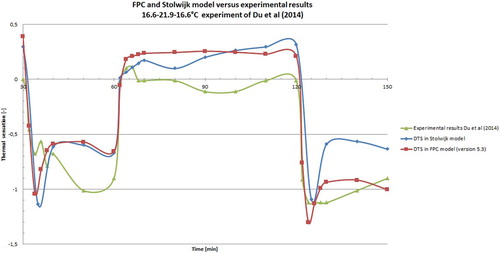
Experiments of Hong Liu et al. (Citation2014)
Experiments were conducted in a climate chamber (Room 1, 4m*3m*2.7 m) and an adjacent air-conditioning room (Room 2, 4m*3 m*2.9 m) with a door connecting them. The environmental variables for these two rooms can be individually controlled. The climate chamber was used to create three temperatures, 32°C, 30°C, 28°C which were selected to represent the ambient temperatures that occur in the warm seasons, while the air-conditioning room was used to maintain a neutral one of 25°C. The temperature differences between the two rooms are 7 K, 5 K, and 3 K, respectively. The relative humidity (RH) in both rooms were controlled to be approximately 60% and air velocity was less than 0.1 m/s. A total of 20 healthy male college students ranging in age from 22 years to 25 years participated in the experiments. All the students were not currently taking prescription medication and had no history of cardiovascular disease. Subjects were asked to avoid caffeine, alcohol, and intense physical activity at least 12 h prior to tests. Each subject provided his or her basic information (e.g. age, height, weight) prior to the tests, and participated voluntarily in all three tests. They were briefed on the purpose of the tests, were familiar with experimental procedures and were trained to know the test procedure well. During the experiment period, they were required to wear a uniform clothing including short-sleeved T-shirt, short trousers and socks with an insulation level of 0.33 clo (1clo = 0.155 m2 K/W) referenced from clothing garment checklists in ASHRAE Standard 55. All experiments were conducted in summer from June to July in 2012, but not immediately after breakfast or lunch. Each test experience lasted for 2 h. In each test, the subject arrived at Room 2 and rested for about 20 min, then entered the climate chamber (Room 1) and put on uniform clothing. Before the beginning of the experiment, subjects were given sedentary activities (reading) for 30 min for acclimation to the thermal environment and keep the metabolism stable. The thermal sensation survey and skin temperature measurements were performed simultaneously. Subjects were asked to report their perception in a questionnaire every 10 min. After 30 min, the subjects moved into the cooler chamber (Room 2). The subjects voted for their thermal sensation immediately after entering Room 2. Next, the subjects completed a 60-min test in Room 2 where they voted for their thermal sensation every 2 min in the early 10 min and then every 10 min for the rest 50 min. Finally, the subjects returned back to Room 1 remaining for 30 min. In the final 30 min, they voted every 2 min in the early 10 min and every 10 min for the rest 20 min. The skin temperature was recorded every minute in the whole test (Liu et al. Citation2014).
The results of their (Slightly) Warm - Neutral – (Slightly) Warm experiments as well as the DTS calculation results of the simulation with the modified Stolwijk model and the FPC model are displayed in the of the temperature intervals 28-25-28°C, 30-25-30°C, 32-25-32°C respectively.
Figure 8. Slightly Warm: 28.0°C/RH = 61.0, Neutral: 25.4°C/RH = 60.9%, Slightly Warm: 28.0°C/RH = 61.2%.
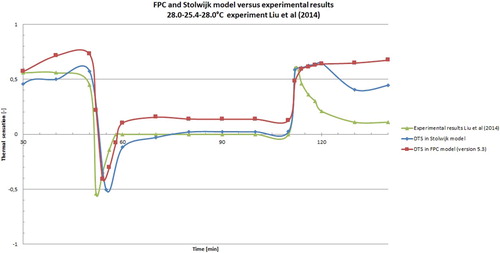
Figure 9. Slightly Warm: 29.9°C/RH = 59.5, Neutral: 25.4°C/RH = 58.1%, Slightly Warm: 29.9°C/RH = 59.4%.
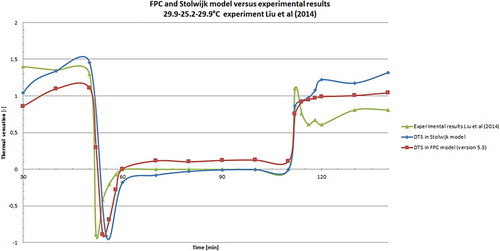
shows an overview of the average deviation in the figures of the calculated DTS value compared to the experimental results.
Table 1. Average deviation calculated DTS value compared to the experimental results.
Conclusion
Based on the calculation results compared to the experimental results, it can be concluded that, in the case of a homogenous step-change transient thermal environment and for sedentary activity:
the calculation results of the Dynamic Thermal Sensation (DTS) equation in the FPC model (version 5.3) and the modified Stolwijk model approach the experimental results fairly accurately
the calculation results of the DTS equation in the modified Stolwijk model does not fall short of the calculation results of the DTS equation in the current FPC model
the models behave quite similar to the experimental results of Gagge, Stolwijk, and Hardy (Citation1967)
in the first and last phases the graphs show a trend of the two models showing constant under-/overestimating the thermal sensation in comparison to the recent experiments (Du et al. Citation2014; Liu et al. Citation2014)
the DTS equation can also be used in combination with the Stolwijk model, as it appears in the situations considered here, despite the fact that the Dynamic Thermal Sensation has been developed for use in the Fiala physiology model,
by adding the Dynamic Thermal Sensation to the Stolwijk model, the Stolwijk model has become more valuable for use in professional practice within the built environment.
Disclosure statement
No potential conflict of interest was reported by the author.
Notes on contributor
Paul Roelofsen studied Architecture, Urban Planning and Housing at the Eindhoven University of Technology specialising in the Physical Aspects of the Built Environment. In 2016 Paul received his PhD degree at the Delft University of Technology. Paul Received the Well Accredited Professional (Well AP) credential through the Well Building Institute (IWBI). With which he belongs to a group of leading professionals, who are committed to promote human health and Well-being in the built environment.
References
- Berglund, L., M. Yokota, and A. Potter. 2013. Thermo-physiological Responses of Sailors in a Disabled Submarine with Interior Cabin Temperature and Humidity Slowly Rising as Predicted by Computer Simulation Techniques. Natick, MA: Biophysics and Biomedical Modeling Division. U.S. Army Research Institute of Environmental Medicine.
- Du, Xiuyuan, Baizhan Li, Hong Liu, Dong Yang, Wei Yu, Jianke Liao, Zhichao Huang, and Kechao Xia. 2014. “The Response of Human Thermal Sensation and its Prediction to Temperature Step-change (Cool-neutral-cool).” Plos One 9 (8): 1–10.
- Ergonsim. 2016. “FPC-model (version 5.3) User Manual.” Ergonsim, Marxzell.
- Fiala, D. 1998. Dynamic Simulation of Human Transfer and Thermal Comfort. Leicester: Montfort University Leicester.
- Fiala, D., K. Lomas, and M. Stohrer. 2003. “First Principles Modelling of Thermal Sensation Responses in Steady State and Transient Boundary Conditions.” ASHRAE Transactions 109 (1): 179–186.
- Gagge, A. P., A. P. Fobelets, and L. G. Berglund. 1986. “A Standard Predictive Index of Human Response to the Thermal Environment.” ASHRAE Transactions, Vols. %1 van %2Vol. 92, part2.
- Gagge, A., J. Stolwijk, and J. Hardy. 1967, January 10. “Comfort and Thermal Sensations and Assiocated Physiological Responses at Various Ambient Temperatures.” Environmental Research 1: 1–20. doi: 10.1016/0013-9351(67)90002-3
- Gordon, R. 1974. The Response of a Human Temperature Regulatary System Model in the Cold. Santa Barbara, CA: University of California.
- Ingegneria medica Universita’ di Tor Vergata Roma. 2016. [Online]. Geopend February 15, 2016. http://ingegneriamedica.altervista.org/doc/termoregolazione.pdf.
- Katic, K., W. Zeiler, and G. Boxem. 2014. “Thermophysiological Models: A First Comparison.” BauSIM 2014 - Fifth German-Austrian IBPSA Conference, Aachen.
- Liu, Hong, Jianke Liao, Dong Yang, Xiuyuan Du, Pengchao Hu, Yu Yang, and Baizhan Li. 2014. “The Response of Human Thermal Perception and Skin Temperature to Step-change Transient Thermal Environments.” Building and Environment 73: 232–238. doi: 10.1016/j.buildenv.2013.12.007
- Miskovish, R., J. Byerly, and S. Miller. 2014. “Adaptation of 25-Node Human Thermal Model for Use in Sierra Nevada Corporation’s Dream Chaser® System-level Thermal Desktop Model.” Thermal & Fluids Analysis Workshop (TFAWS) 2014 Proceedings, NASA, Glenn Research Center, Cleveland.
- Munir, A., S. Takada, T. Matshushita, and H. Kubo. 2010, March. “Prediction of Human Thermophysiological Responses During Shower Bathing.” International Journal of Biometeorology 54 (2): 165–178. doi: 10.1007/s00484-009-0265-9
- Munir, A., S. Takada, and T. Matsushita. 2009. “Re-evaluation of Stolwijk’s 25-Node Human Thermal Model Under Thermal-transient Conditions: Prediction of Skin Temperature in Low-Activity Conditions.” Building and Environment 44 (9): 1777–1787. doi: 10.1016/j.buildenv.2008.11.016
- NEN-EN-ISO-7730. 2005. Ergonomics of the Thermal Environment - Analytical Determination and Interpretation of Thermal Comfort Using Calculation of the PMV and PPD Indices and Local Thermal Comfort Criteria (ISO 7730:2005.IDT). Delft, Zuid Holland: Nederlands Normalisatie Instituut.
- Roelofsen, P. 2016. Modelling Relationships between a Comfortable Indoor Environment, Perception and Performance Change. Delft: Printservice Ede.
- Roelofsen, C., and P. Vink. 2016. “Improvement of the Stolwijk Model with Regard to Clothing, Thermal Sensation and Skin Temperature.” Work 54: 1009–1024. doi: 10.3233/WOR-162357
- Stolwijk, J., and J. Hardy. 1966. “Temperature Regulation in man - A Theoretical Study.” Pflugers Archiv 291: 129–162. doi: 10.1007/BF00412787
- Stolwijk, J., and J. Hardy. 1977. Control of Body Temperature, in Handbook of Physiology. Bethesda, MD: American Physiological Society, pp. 45–68.
- Woerlee, M. 1982. “SETMA – A Mathematical Model of the Human Thermoregulation for Predicting Thermal Comfort Under Various Environmental Conditions, BGD-report 305/38.” Medical Department, section Work Physiology, The Hague.
- Zhang, H. 2003. “Human Thermal Sensation and Comfort in Transient and Non-Uniform Thermal Environments.” PhD thesis., Berkeley.
- Zhou, X., H. Zhang, Z. Lian, and L. Lan. 2014. “Predict Thermal Sensations of Chinese People Using a Thermophysiological and Comfort Model.” Preprint, Proceedings of Indoor Air 2014.

